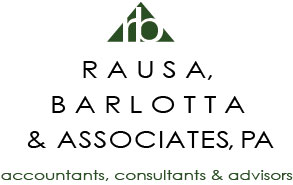Business Tax Changes In The “Tax Cuts And Jobs Act”
On December 22, President Trump signed into law the “Tax Cuts and Jobs Act” , a sweeping tax reform law that will entirely change the tax landscape. This article below by Thomson Reuters Checkpoint describes the Act’s changes that would affect businesses, including the new rates , elimination of the alternative minimum tax, and increased Code Section 179 expensing. Please note that not every provision of this tax act is presented.
Corporate tax rates reduced
For tax years beginning after Dec. 31, 2017, the corporate tax rate is a flat 21% rate.
Dividends-received deduction percentages reduced
For tax years beginning after Dec. 31, 2017, the 70% dividends-received deduction is reduced to 50% and the 80% dividends-received deduction for 20% or more owned corporations is reduced to 65%.
Corporate alternative minimum tax repealed
For tax years beginning after Dec. 31, 2017, the corporate AMT is repealed. For tax years beginning after 2017 and before 2022, the AMT credit is refundable and can offset regular tax liability in an amount equal to 50% (100% for tax years beginning in 2021) of the excess of the minimum tax credit for the tax year over the amount of the credit allowable for the year against regular tax liability. Accordingly, the full amount of the minimum tax credit will be allowed in tax years beginning before 2022.
Increased Code Section 179 expensing
For property placed in service in tax years beginning after Dec. 31, 2017, the maximum amount a taxpayer may expense under Code Section 179 is increased to $1 million, and the phase-out threshold amount is increased to $2.5 million. For tax years beginning after 2018, these amounts (as well as the $25,000 sport utility vehicle limitation) are indexed for inflation.
Qualified real property. The definition of Code Section 179 property is expanded to include certain personal property even though it is used predominantly to furnish lodging or in connection with furnishing lodging. The definition of qualified real property eligible for Code Section 179 expensing is also expanded to include the following improvements to nonresidential real property after the date such property was first placed in service: roofs; heating, ventilation, and air-conditioning property; fire protection and alarm systems; and security systems. Also any other building improvements to nonresidential real property that aren’t elevators or escalators, building enlargements or attributable to internal structural framework are Code Section 179 property.
Luxury automobile depreciation limits increased
For passenger automobiles placed in service after Dec. 31, 2017 for which the additional first-year depreciation deduction is not claimed, the maximum amount of allowable depreciation is increased to: $10,000 for the year in which the vehicle is placed in service, $16,000 for the second year, $9,600 for the third year, and $5,760 for the fourth and later years in the recovery period. For passenger automobiles placed in service after 2018, these dollar limits are indexed for inflation. For passenger autos eligible for bonus first-year depreciation, the additional first-year depreciation allowance remains at $8,000.
Computers removed from listed property
Computer or peripheral equipment is removed from the definition of listed property, and so isn’t subject to the heightened substantiation requirements and possible slower cost recovery that apply to listed property.
Recovery period for certain real property improvements is shortened
For property placed in service after Dec. 31, 2017, the separate definitions of qualified leasehold improvement, qualified restaurant, and qualified retail improvement property are eliminated, and a general 15-year recovery period and straight-line depreciation are provided for qualified improvement property (generally a less restrictive category than the aggregate of the three categories that it replaces. A 20-year ADS recovery period is provided for such property.
Thus, qualified improvement property placed in service after Dec. 31, 2017, is generally depreciable over 15 years using the straight-line method and half-year convention.
For property placed in service after Dec. 31, 2017, the ADS recovery period for residential rental property is shortened from 40 years to 30 years.
For tax years beginning after Dec. 31, 2017, an electing real property trade or business—i.e., a real property trade or business electing out of the limitation on the deduction for interest—must use ADS to depreciate any buildings or qualified improvement property.
Limits on deduction of business interest
For tax years beginning after Dec. 31, 2017, every business, regardless of its form, is generally subject to a disallowance of a deduction for net interest expense in excess of 30% of the business’s adjusted taxable income. The business interest limitation generally applies at the taxpayer level. However, for partnerships and S corporations, the limitation applies at the entity level.
For tax years beginning after Dec. 31, 2017 and before Jan. 1, 2022, adjusted taxable income is computed without regard to deductions allowable for depreciation, amortization, or depletion and without the former Code Sec. 199 domestic production activities deduction (which is repealed effective Dec. 31, 2017).
Under a small business exception, the business interest limitation doesn’t apply to taxpayers (other than tax shelters) for a tax year if the taxpayer’s average annual gross receipts for the three-tax year period ending with the prior tax year don’t exceed $25 million. Real property trades or businesses can elect out of the limitation if they use ADS to depreciate applicable real property used in a trade or business.
Modification of net operating loss (NOL) deduction
For NOLs arising in tax years ending after Dec. 31, 2017, the two-year carryback and the special carryback provisions are repealed, but a two-year carryback applies for certain losses incurred in the trade or business of farming.
NOLs generally can be carried forward indefinitely.
For losses arising in tax years beginning after Dec. 31, 2017, the NOL deduction is generally limited to 80% of taxable income (determined without regard to the NOL deduction). Carryovers to other years are adjusted to take account of this limitation.
Like-kind exchange treatment limited
Generally effective for transfers after Dec. 31, 2017, the rule allowing the deferral of gain on like-kind exchanges is modified to allow for like-kind exchanges only with respect to real property that is not held primarily for sale. However, under a transition rule, the pre-Act like-kind exchange rules apply to exchanges of personal property if the taxpayer has either disposed of the relinquished property or acquired the replacement property on or before Dec. 31, 2017.
Employer’s deduction for fringe benefit expenses limited
For amounts paid or incurred after Dec. 31, 2017, deductions for entertainment expenses are disallowed, eliminating the subjective determination of whether such expenses are sufficiently business related; the current 50% limit on the deductibility of business meals is expanded to meals provided through an in-house cafeteria or otherwise on the premises of the employer; and deductions for employee transportation fringe benefits (e.g., parking and mass transit) are denied, but the exclusion from income for such benefits received by an employee is retained. In addition, no deduction is allowed for transportation expenses that are the equivalent of commuting for employees (e.g., between the employee’s home and the workplace), except as provided for the safety of the employee.
Cash method of accounting
For tax years beginning after Dec. 31, 2017, the cash method of accounting may be used by taxpayers (other than tax shelters) that satisfy a $25 million gross receipts test, regardless of whether the purchase, production, or sale of merchandise is an income-producing factor. This means that taxpayers with annual average gross receipts that do not exceed $25 million (indexed for inflation for tax years beginning after Dec. 31, 2018) for the three prior tax years are allowed to use the cash method.
Accounting for inventories
For tax years beginning after Dec. 31, 2017, taxpayers that meet the $25 million gross receipts test are not required to account for inventories, but rather may use an accounting method for inventories that either (1) treats inventories as non-incidental materials and supplies, or (2) conforms to the taxpayer’s financial accounting treatment of inventories.
New deduction for pass-through income
For tax years beginning after Dec. 31, 2017 and before Jan. 1, 2026, the Act adds a new deduction for noncorporate taxpayers for qualified business income–also referred to as the “pass-through deduction.” The deduction reduces taxable income, rather than adjusted gross income (AGI), but is available to taxpayers who take the standard deduction.
The deduction is generally 20% of a taxpayer’s qualified business income (QBI) from a partnership, S corporation, or sole proprietorship. QBI is defined as the net amount of items of income, gain, deduction, and loss with respect to the trade or business. Certain types of investment-related items are excluded from QBI, e.g., capital gains or losses, dividends, and interest income (unless the interest is properly allocable to the business), as are employee compensation and guaranteed payments to a partner.
Taxpayers in service related businesses, such as healthcare professionals, law, accounting, actuarial science, performing artists, consulting, athletics, financial services, brokerage services, including investing and investment management, trading, or dealing in securities, partnership interests, or commodities, and any trade or business whose principal asset is the reputation or skill of one or more of its employees are eligible. However, the deduction with respect to service businesses is phased out if the taxpayer’s taxable income exceeds the threshold amount of $157,500 ($315,000 in the case of a joint return).
Taxpayers whose taxable income exceeds the threshold amount of $157,500 ($315,000 in the case of a joint return) are also subject to limitations based on the W-2 wages and the adjusted basis in acquired qualified property.
For partnerships and S corporations, the deduction is taken at the partner or shareholder level. Trusts and estates are eligible for the deduction, subject to apportionment between the trust or estate and the beneficiaries.
Source: Thomson Reuters Checkpoint, “Complete Analysis of the Tax Cuts and Jobs Act”.



